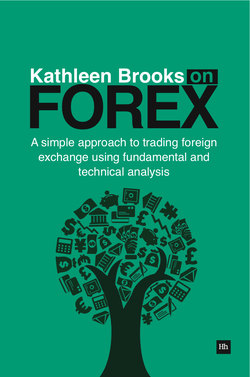Читать книгу Kathleen Brooks on Forex - Kathleen Brooks - Страница 9
На сайте Литреса книга снята с продажи.
ОглавлениеTrading using economic data
The way to get the information needed for fundamental analysis is to look at the official economic data releases. For most of the world’s major economies, economic data is released regularly and it gives a glimpse of the overall economy and how fast it is growing. The key thing for me is that economic growth means future prosperity, which should then equate to a strengthening currency. Traders seek out growth because that is usually where the best opportunities lie to jump on an uptrend. Alternatively, economic data showing weakness in a country’s economy has the effect of weakening the currency.
The markets have a tendency to price in future growth and prosperity. The forex market, like the stock market, is thought to price in future growth expectations up to six months in advance. Hence markets don’t wait for the GDP release that comes out every three months before deciding on the direction of a currency; they react to the incremental flow of data from economic indicators throughout the month in anticipation of what that means for GDP and the overall health of the economy.
In addition to GDP the other indicators include inflation data, retail sales, industrial and manufacturing data, and data on consumer confidence. These are a timely update on the state of the economy and the occasions of their release can be major market-moving events.
In fact, there are thousands of economic indicators and it could make you dizzy if you tried to analyse them all and determine what they mean for growth. As an example of some of the kookier ways of measuring economic growth, some people may look at the hog market to try and detect Chinese consumption of pork and use that to deduce the strength of the Chinese economy. Others have been known to search out demand for a certain chemical found in paint and then try to apply that to demand for housing in the US.
Thankfully there are more accessible ways to understand what is going on from an economic perspective and for some people it is most effective to narrow the list down to a few key indicators. It is also possible to prioritise the indicators so that you can organise your analysis and know which to pay most attention to. I will now move on to introduce the economic indicators that I have found to be of most use in my own fundamental analysis. Before I do, a couple of words on finding economic data.
Use of an economic calendar
It is important to know when economic data is released and the easiest way to get this information is by using a calendar. You can get reliable up-to-date calendars on economic news websites like Bloomberg (www.bloomberg.com/markets/economic-calendar), some blogs have them – like Forex Factory (www.forexfactory.com), and the financial press often prints economic calendars at the start of each week. Also, ask your FX broker as they may provide you with a free calendar. Some even contain widgets that let you place orders or trade directly from the calendar.
Consensus
The key thing for traders to remember is that the actual data that comes out is only relevant based on whether it hits, misses or exceeds consensus. Consensus is an important word for the markets. Usually economic data calendars include the market’s expectation of the data release. The expected number is the mean of estimates from a number of economists who have been polled prior to the event and asked to give their views on what the number will be. Reuters and Bloomberg are some of the most popular data providers that measure the street’s expectations prior to major data releases.
As a general rule, a data miss (the figures released are worse than the forecasts) can be currency negative, a number around expectations usually has a negligible effect, and if the reading exceeds expectations this tends to be currency positive.
